THE OLD STAG
Stories
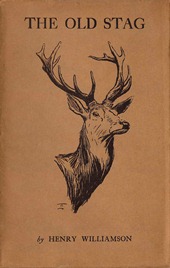 |
|
| First edition, Putnam, 1926 |
First published G. P. Putnam's Sons Ltd, October 1926
Dutton USA, early 1927
New revised edition illustrated by Charles F. Tunnicliffe, Putnam, 1933
Reprinted many times subsequently
Dedication:
‘To Windle’s Mother’
(HW’s wife, Ida Loetitia, mother of their first-born, William, born February 1926)
The first book by HW to be published by Putnam, it had a plain brown paper dust wrapper with a sketch of the head of a red-deer stag by Lionel Edwards, a well-known and well-respected sporting artist and friend of A. J. Munnings.
The blurb on the front cover flap states:
This is a book of the countryside. Red-deer, foxes, herons, badgers, falcons, sun and sea and wind live in its pages, as they could only be made to live by one who has himself lived with them. There is the excitement of the chase, the natural human pity for the hunted, the intense joy of the bird “wild in its native air” – told in English that is precise and beautiful. The book reflects a personality original and vital, and every page testifies to the author’s extraordinary powers of observation and interpretation. Of the author’s earlier book, “The Peregrine’s Saga”, Mr. John Galsworthy wrote – “I’ve been greatly struck by it. He has a real gift – many real gifts. You see – he sees, and that’s rare; he will come into his own.”
[The Galsworthy quote is from a letter he sent to Edward Garnett in 1926, but he was actually writing about The Old Stag – see text further down.]
A large file of letters shows that HW had entered into a close working relationship with Constant Huntington, his new editor at Putnam – indeed Huntington took over some of the duties of ‘agent’ and began placing articles in magazines, which drew a rather hurt reproach from the faithful and diligent Andrew Dakers.
The book designer/typesetter at Putnam was T. M. Ragg, and it is obvious that he took a great pride in his work. There are a number of letters from him in the archive (mainly to do with his work on Tarka the Otter) which show how careful he was. Most extraordinary is that for this book (The Old Stag) the first produced by Putnam, Ragg sent for HW’s approval a dummy – a completely made-up but totally blank book, bound in brown-red cloth, titling fully gold-stamped. An MS note by Ragg written inside (in brown-red ink – exactly matching the cover!) states:
THE OLD STAG
This is not actually the paper which will be used, but bulk and
no. of sheets will be as this. T. M. Ragg.
What a wonderfully extravagant gesture! HW later used just two pages of this blank book for notes for stories – otherwise all 300 pages remain blank.
HW’s life had now changed radically. In the early summer of 1924 he had met (while out with the Cheriton Otter Hunt gaining material for what was to be his best-known book, Tarka the Otter) a beautiful dark-haired girl, Ida Loetitia Hibbert (whom he called Gipsy), and they were married on 6 May 1925. Their first child, a son, William Hibbert Williamson (always called ‘Windles’ in the family – thus explaining the dedication here) was born in February 1926. They had moved out of the tiny Skirr Cottage at the end of summer 1925, taking over the lease of the much larger Vale House, situated at right angles to that row, merely a few yards away.
Apart from the ‘interruption’ of marriage, and its attendant honeymoon visit to the battlefields of the First World War, HW’s main energy at this time was concentrated on the writing of Tarka the Otter. HW is complaining in letters to Dakers and Constant Huntington, his new editor at Putnam, that he is very in need of money – indeed, he applied for a grant to cover maternity expenses (a nursing home) to the Royal Literary Fund. No new book had been published since The Dream of Fair Women (1924) and also the American edition of The Peregrine’s Saga (1925), although HW’s agent, Andrew Dakers, was diligently selling short stories for him, mainly to American periodicals.
It is these stories, plus some new ones previously unsold, that were put together to form The Old Stag. There are twelve stories only, so they are more substantial than those of the previous collections. I will describe the stories in some detail: they are all different but each one in its own way is a gem – indeed they are perfect examples of the short-story genre, which in recent years have not had the attention they deserve.
Stumberleap: the opening and pivotal story about ‘the girt old stag of Stumberleap wood’ (‘girt’ meaning here ‘big and rangy’). HW opens his story with a confidential and seemingly inconsequential few paragraphs about his childhood school lessons and his fantasies about any creature that came into them; en route ‘carelessly’ letting us know that the story is to be about a red deer stag and indeed a hound named Deadlock, who afterwards was released to an otter hunt. (Deadlock has, of course, the role of ‘villain’ in Tarka the Otter – soon to be unleashed upon the world.) We are told the life story of the stag to date, the technical terms dropped into the prose like plums in the pudding: the Stumberleap stag lives his life naturally, as do all the red deer of Exmoor.
But Stumberleap is being tracked and marked by a ragged little man known as the harbourer, whose purpose in life is to find the hiding place of a deer for the sport of the Hunt, meeting at Stumberleap Farm, situated near Dunkery Beacon, high on Exmoor. (HW and Loetitia spent the first few days of their honeymoon in May 1925 on just such a farm.)
The story tells of the long chase of Stumberleap across Exmoor, ending with a storm which allows Stumberleap, after a final confrontation with Deadlock, to take advantage of a flooded stream to escape down a cleave and on out to sea, to swim across the Severn Estuary, followed by 15½ couple of hounds (out of the full 40 couple). These hounds drown, their fish-eaten carcasses eventually being washed up in Cardiff harbour. Stumberleap crossed the Severn Sea safely and lived on near the coast of Wales for many years:
. . . a wooded hill overlooking the Severn Sea, and in the wood lives a wild stag, who sometimes gazes across twenty miles of water to the dim blue moor of his birth. [But death is inevitable, for] . . . the last antlers have grown and dropped from the stag’s head. . . .
Deadlock, after having ‘eleven thorn stitches’ on his belly to close the wound made by Stumberleap’s antler (as we are told right at the beginning of the story), lived:
But his pace was gone from him; and he was drafted to the otter hunters who walk in the valleys.
Stumberleap is known to have been based on a true story.
Hugoe Matthews, in his Henry Williamson: A Bibliography, states that the story first appeared in three American magazines, The Saturday Evening Post, Collier’s, and Pearson’s, in 1925. (Though that seems a little odd to me – unless there was some double selling by Dakers and Huntington!)
A letter from Andrew Dakers, dated 27 August 1924, states that he had heard from ‘Wade’ re The Story of Stumberleap, they can use it if allowed to cut from 8,000 words to 5,000. HW has scribbled on this: ‘Pearson’s Mag. (may get £25 from Wade, & £100 from American Mag.)’ The printed story in the book, thirty pages long, is about 8,500 words.
Written during the same period, it is obvious to any HW reader that this story is parallel to, or an offshoot from, Tarka the Otter. There is also a most strangely coincidental nuance of the final scene of The Gale of the World, the volume that ends the later series A Chronicle of Ancient Sunlight.
No Eel for Nog: (Matthews states that this was first published in Hutchinson’s magazine, September 1925, and Collier’s in the USA, April 1925.) It is the story of a day in the life of a heron – Old Nog, twenty years of age – spent fishing for food for himself and his ravenous offspring, his mate having been recently killed by a peregrine of the famous house of Chakchek, an ancient lineage which has been famous in the area throughout the historic events of this land. When his crop is full – of duckling, rat, rainbow trout, beetle, frog, and finally, eel – Old Nog prepares to fly back to the heronry nest.
But Chakchek and his mate and young are watching Old Nog, ‘waiting on’ 1,000 feet in the sky. As the heron heads for his nest, the peregrines attack, stooping from a great height and fastening onto the heron, taking him down and forcing him to disgorge the contents of his crop. On the ground Old Nog uses his beak as a spear, fighting for his life, and blinding the young peregrine in one eye; eventually the peregrines give up and climb back to the high sky. After resting and recovering, Old Nog re-swallows his own prey and then heads for home. But the peregrines attack again, clinging to his back: Old Nog dives down and into the river.
The scene changes to Old Nog returning to the heronry, exhausted but having to yield his crop contents – trout, rat, duckling and eel, retrieved with such great death-defying derring-do – to his ‘two great grawbeys’ (equating to two greedy teenagers), a task that he had been undertaking for twenty years, while:
Far away over Exmoor a young peregrine was soaring alone – his parents drowned. Chakchek is dead – long live Chakchek the One-Eyed!
Thus we learn here, in a story about a heron, the background to ‘The Saga of Chakchek the One-eyed’ that had appeared in The Peregrine’s Saga two years previously.
Bill Brock’s Good Turn: (Matthews states that this appeared first in the American magazines Saturday Evening Post or Pearson’s in 1925.) This is the story of a fierce and gory fox-hunt – hounds led by Nimrod versus Fang-over-lip (a fox) who, exhausted, finally takes refuge in the holt of Bloody Bill Brock, a 40lb boar badger. Most unusually the fox is allowed access to the badgers’ underground citadel. ‘Nimrod’ is an ancient name for ‘Great Hunter’: its source is from the Bible – Genesis X, v. 8,9: ‘And Cush begat Nimrod: he began to be a mighty one in the earth. He was a mighty hunter before the Lord.’ It is of course the title of one of Elgar’s Enigma Variations, and that may have been HW’s immediate source.
Bloody Bill Brock, now alert, attacks Daisy the terrier sent in to flush out Fang-over-lip. Diggers are sent for, but Bloody Bill Brock emerges and attacks first Nimrod then various other hounds: in chaotic order the rest then chase the badger, with various skirmishes en route until the badger returns, limping with wounded paws, to his own holt.
The final paragraph reveals the reason for the badger’s protection of the fox. In the holt are some rusty traps. Years before, the fox had dug out these iron gins in which the badger was caught – thus allowing him to live, and so to father a large dynasty of brocks. So the fox is considered a friend and not an enemy, as would usually be the case.
An interesting side issue of this story is that it is set around Rookhurst, which is the village, somewhere in the West Country, where the family home of the fictional Maddison family (the core of the Flax of Dream novels, the writing of which was then in progress) is located. Fang-over-lip is first discovered in the Big Wheatfield, where in the middle stands ‘Crowstarver’s Spinney’. HW is weaving a complicated ‘cat’s cradle’: he is linking this story to his novels, but further, the Big Wheatfield with its Crowstarver’s Spinney is actually drawn from his childhood visits to his cousins (the Boon family), who lived at Aspley Guise in Bedfordshire. This field and spinney lay behind their home and could be accessed from the garden there. But Rookhurst was always an imaginary place and is drawn from various aspects and sources.
HW expands on this spinney in his story ‘The Crowstarver’, which appeared in the 1928 Collin’s ‘Pocket Novel’ edition of The Lone Swallows, and again, retitled as ‘Boy’, in the Putnam 1933 illustrated edition. There is great poignancy attached to this once the reader knows that both the cousin, Charlie Boon, and the Crowstarver, Jim Holloman, were killed in action in the First World War.
Mewliboy: (First appeared in Twenty-Story Magazine, February 1925.) This story has several hallmarks derived from The Star-born, with references to the ‘Quill Spirit’ and the ‘Star-dwarf some call the Sun’. Interestingly the setting is Windwhistle Cross. This is Ox’s Cross above Georgeham, where HW would, in due course, buy his field and build his writing hut: evidence of the importance of this place to him at an early stage.
Wheeoo the buzzard has been caught in a trap by her legs, and in her frenzy to escape lays an egg there. The trapper finds the egg and puts it under his broody Wyandotte hen; in due course it hatches out. This is Mewliboy. Wheeoo had escaped but is very handicapped by her broken legs and cannot really carry out her nesting duties. The trapper returns Mewliboy to the original nest where the male buzzard gets an unmated female to take over feeding duties. When Mewliboy flies he is caught by the gardener and returned to the trapper. Wheeoo stays nearby. Then Chakchek the Backbreaker catches a partridge near the cage. The trapper decides to release Mewliboy, and he and Wheeoo fly off together: a rare happy ending – which pre-empts again the later novel The Gold Falcon.
The star of all the falcons flickered gold wings as it flew in eternal watchfulness.
The Trapper’s Mates: here we find further cross-references to other books – for example, d’Essantville Castle, where the viscounts are blooded before they can walk and are taught to be gentlemen (actual and metaphorical), harks back to The Dream of Fair Women.
This story revolves around a bob-tailed fox. In a pub the narrator (‘I’ = HW) meets a pig farmer (large and porcine like his products) and we hear that the fox lost its brush because ‘one of my boars bit it off when he was a cub’. He tells the tale: the keeper gets Tom Cockerlegg the trapper to catch foxes which are put into the apple cellar. One of these foxes is given to the pig farmer, who rears her, and she has cubs by Fang-over-lip (of previous fame). It is one of these young cubs that has had its tail bitten off by a boar pig.
There enters into the pub a dirty wizened man with a sheepdog: this is Tom Cockerlegg the trapper, a very crafty being, who shows that he has no love for Bob-tail. They talk and the narrator offers the old man tobacco from his pouch. Tom Cockerlegg gets out his watch while he fills his pipe: when the pouch is returned, our narrator finds that it is now oddly half empty.
Three days later there is a Hunt. Nimrod leads the pack (his paw now healed). Tom Cockerlegg knows where a fox (Bobtail) is, and as a reward asks the Master for some ‘baccy’: again he gets out his watch – and this time the narrator notices that it is empty of workings, and that Tom, turning away, fills it cram full with the Master’s expensive mix (thus explaining the previous sleight of hand over his own tobacco pouch).
The Hunt progresses, and eventually the narrator is alone and sees the fox, noticing it is now, strangely, wearing a collar. The trapper is also nearby, and the two get talking. Nimrod gets on the trail of Bobtail and the Hunt proceeds, and eventually crosses the Big Wheatfield (note again) where there is a scarecrow and a gibbet with a dead crow, and goes into Crowstarver’s Spinney.
Tom Cockerlegg now gives a call indicating he has seen the fox, and hounds go rushing off to his directions, but this is a false alarm, to the annoyance of the pig-farmer. They all pause for a breather in Crowstarver’s Spinney: the narrator is invited to drink from the Master’s hunting flask (these are special flasks that have rounded bottoms and cannot be set down) – a great honour – and as he tilts his head to drink, he sees the fox looking down from the top of the hollow tree under which they are all standing.
Realising that there is more to this than meets the eye, the narrator stays behind when the Hunt moves off again, and watches Tom Cockerlegg the trapper call the fox down and remove the collar, which belongs to his own sheep dog (as the narrator had realised). The trapper explains that the fox is his ‘good mate’, and that he had found it as a cub, weak from hunger and pain from its lost tail, and had put it with his dog, Bess, and her own litter of pups. This ‘hunt’ charade is a regular occurrence.
Bess and the fox play together, and Tom gets both of them to shake hands with the narrator, further offering him some ‘baccy’. The narrator thinks he is going to get a pipe of the quality tobacco provided by the Master, but instead is offered the pouch filled with shag (cheap stuff and unsmokable!). As Tom turns to leave, he gets out the watch to fill his own pipe, chuckling to himself as he disappears.
The Flight of the Pale Pink Pyjamas (first appeared in Collier’s, 1925): The narrator (HW) tells us about Major Arthur Cavan, VC, DSO, MC, ornithologist, bird photographer and film-maker, ex-Royal Flying Corps ace who had brought down nine German planes in less than three minutes, and who lives seven miles from the narrator’s home (i.e. Georgeham). The narrator relates that he had written a story about Red Kites. Major Cavan is writing an official paper on them, thinking them to be extinct in Britain. He has invited the narrator to visit and exchange information.
The narrator meets him in a meadow where Cavan is exercising his tame Norwegian goshawks and a red kite, called Barcud ('Cavan had given it the old Welsh name for the Red Kite'). He had had a pair, hoping to breed from them, but one had died. Cavan relates that his wife had been upset that day to find some washing (her delicate underwear) had mysteriously disappeared from the linen line where drying. As the two men talk they notice something pink flying about in the sky. Then, with great excitement and amazement, Cavan realises that they are his wife’s pale pink pyjamas and that they have been ‘stolen’ by a wild red kite – a bird that the narrator/HW had known about for over a year and named Glead (an ancient word meaning ‘glider’). A bird referred to as an ‘oodmall’ in the story is a Devon word for a green woodpecker.)
Cavan sets his goshawks free to attack the wild red kite. The ‘tame’ tethered red kite becomes very agitated, so he cuts her leather thongs and jesses to let her go free and she flies up and joins the wild bird. The goshawks, outwitted by the kites, eventually give up and return home: the kites fly off and ‘live happily ever after’ – later that year producing four young.
The moral seems to be that a scientific approach (Cavan, who thought red kites extinct in Britain) is inferior to that of a keen amateur naturalist (HW, who through patient field work and observation knew they were not). Such seemingly peculiar behaviour by red kites is well known. Shakespeare certainly knew of the trait – as he noted in A Winter’s Tale: ‘When the kite builds, look to lesser linen’ (Act IV, Scene 3); a quotation used by HW in the story.
There was in 1923 a real-life Captain P. C. Cavan who was a member of the Cheriton Otter Hunt and later on its committee. He lived nearby – though slightly more than seven miles distance! One hopes that he was not offended by HW’s use of his name in this story. The fictional Cavan's flying exploits are clearly based on those of the Canadian Billy Bishop, an RFC ace credited with 72 victories, and who won the VC for flying a solo mission behind enemy lines to attack a German airfield, where he claimed that he shot down three aircraft that were taking off, destroying several more on the ground.
T’chakamma: T’chakamma is a baboon – the chief of a tribe living in the Cave of Bats high up a mountain side. As the story opens the baboons are planning a raid on the Intaba Kraal, owned by a Boer farmer. T’chakamma had once been captured and chained up for a long time; he had eventually managed to escape but still wearing the steel collar of captivity and vowing revenge against his tormentors – the white man.
All this is known to Jafta Hallelujah, a Kaffir shepherd (‘kaffir’ is a word that was commonly used in South Africa to signify a black man, no matter of what tribe; it is now considered to be an ethnic slur), who is terrified of baboons, which he holds sacred, but who watches and knows all that goes on.
T’chakamma plots and leads a hunting raid. He is ‘attended’ by a young stalwart pretender, T’je. To the Boer farmer the baboon was a total pest, both killing farm stock and destroying crops. Hearing the noise, he grabs his gun and goes out to face the baboons, although he was sure he would die in the attempt. But although at first confronting him, the baboons suddenly depart.
The farmer then organises a hunting party and seeks out the baboons. A menacing shadow of a bird is seen – we learn later that it is of a vulture flying above, waiting for death to occur. The hunting dogs, well ahead of the men, find the baboons and manage to surround the young pretender, T’je: T’chakamma, hearing his distress cries, comes to his rescue. The leader of the dog pack, Swart Piet (Black Pete) barks to announce his find, and shots are fired at the baboons from a distance.
T’chakamma breaks free, with the youngster held protected, and tries to climb up to the Cave of Bats, but the dogs give chase and attack. The vulture waits on above. T’chakamma makes a stand on a cliff ledge and kills most of the hunting dogs. On a ledge T’chakamma and Swart Piet tussle together: both are wounded. Swart Piet lies exhausted and nearly dead. The vulture lands nearby.
The Boer farmer finally catches up, and seeing the dog mortally stricken fires a dumdum bullet at the baboon. Thinking the baboon is dead, man and dog approach, but T’chakamma springs at the man in a final burst and grabs him, but is bayoneted in the throat. As the farmer tries to free himself from the baboon’s grasp so the vulture launches forward and, using his talons as weapons, knocks him over the cliff ledge.
Jafta Hallelujah has watched all this, and knows that Ngoza, the spirits of dead Kaffirs killed by white men, have in the form of the fearsome T’chakamma had their revenge: and he knows that the spirit of T’chakamma guards the Intaba Kraal against the intrusion of any future white man.
This is a tale very much in the style, or of the genre, of Kipling’s Jungle Stories, or indeed that of Rider Haggard, and one wonders if that was HW’s intent. It also very much fits the story of the modern film The Lion King. In his preface to the later Collected Nature Stories (1970), HW states that ‘T’chakamma’ had been ‘suggested by a crude pen-and-ink sketch of African baboons being attacked by dogs on the lower slopes of a mountain’. His unique imagination supplies a story which is at once totally authentic in its detail and enthralling in its content.
When Charles Tunnicliffe was preparing the woodcuts to go into the illustrated edition of 1933, he wrote the following slightly wry but humorous remark (HW being very fussy about authenticity):
By the way, I hope you don’t expect me to take a little trip to South Africa to get authentic baboons. Please, please may I study them at the Belle Vue Manchester [Tunnicliffe’s nearest zoo].
His subsequent drawing is a most powerful invocation of the spirit of T’chakamma, chief Baboon of the tribe of the Cave of Bats. The visit to his local zoo had proved worthwhile!
A fragment of HW’s manuscript for this story was printed in facsimile in HWSJ 31, September 1995, pp. 60-61, and included a reduced reproduction of ‘Tunny’s’ (HW’s abbreviation for him) very powerful woodcut drawing of T’chakamma.
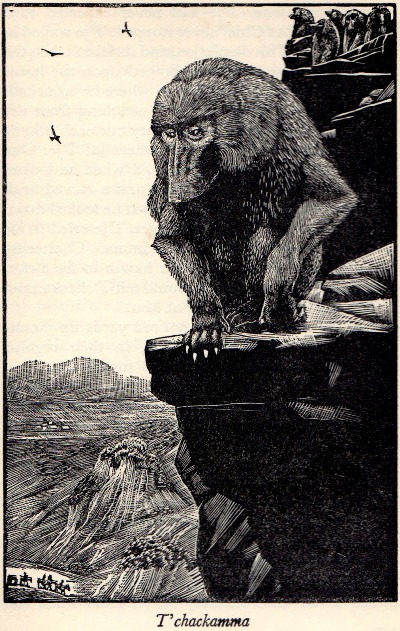
Chakchek’s Raid On London: A peregrine falcon circles a statue, ignored by the scurrying humans below: the statue is Nelson’s Column, nearly 150 feet in height and the peregrine is Wizzle of the Chakcheks, son of the One-eyed, he who had been left an orphan on Bone Ledge, Baggy Point, Devon, in the earlier story. Of the scurrying humans, many of whom were civil servants and elderly ex-servicemen, HW writes:
. . . at the moment most of them thought hatefully and scornfully of another nation, as that nation thought hatefully and scornfully of them.
A newspaper seller is announcing: ‘British Army’s Great Victory – Special’. We learn that it is September 1914. It was not, of course, ‘a great victory’. In some form or other, HW’s bitter and ironic thoughts about the war and its causes are ever present.
An old woman puts some maize on the news-boy’s hat. A pigeon perches to eat it. Wizzle dives and strikes. The ensuing chaos produces rumours of German snipers and spies (showing how jumpy, gullible, and volatile the general populace is).
Wizzle takes himself off to St Paul’s Cathedral, where a plentiful supply of pigeons keeps him well fed. Then he moves on to Hyde Park and kills a green woodpecker, and where he is watched by a
falcon-eyed, white-bearded man who had been watching it through glasses; for the old gentleman had been observing birds in Hyde Park for many years, and he knew that the peregrine falcon was a rare visitor. [This gentleman, it is suggested in a footnote, is the great naturalist and writer W. H. Hudson – one of HW’s mentors: aged 73 in 1914, he died in 1922.]
Wizzle gets caught in a bird-catcher’s net, but takes various chunks out of the hapless netter before escaping his clutches. Not so for a cage of chaffinches, doomed to sing in blind torment. Wizzle makes sport with a flock of pee-wits (green plovers) and with a huge gathering of migrating swallows, in company with a hobby. They all depart for Africa – the hobby thus having its own source of ready meals en route.
Wizzle sets out on his own journey – for peregrine ‘means wanderer’. We are told we will learn of his strange homecoming one night,
when out of the brands on the hearth arise gold antlers and wings and tongues of flame . . .
So here again the tapestry – this huge portrait of natural life – is being interwoven with an aerial thread. Apart from those bitter opening phrases about the attitudes of the establishment towards war and Germany (which become a central theme as time passes), another interesting point here is the reference back to his early short newspaper article about a peregrine being seen on St Paul’s Cathedral: marked ‘UNTRUE’ on the cutting pasted into his ‘Richard Jefferies Journal'. But one should perhaps not take that remark at face value: it may well have been one of HW’s little tricks!
The Yellow Boots: This is the dramatic account of the tragedy that befell an escaped convict which caused the last Hunt of the season of the Incledon Harriers to be mysteriously and summarily cancelled. The Hunt Ball that night took place without the presence of the Master (unheard of!) or his daughter, all of which causing a great furore of speculation and rumour, both among the Hunt and its followers, and the local press. The official story is that the hounds had run amok and worried and killed sheep, and so have all been put down.
The true story is somewhat more macabre. A convict – a double murderer – known only as ‘Seventy-six’ (the number of his cell) had escaped from Princetown Prison on Dartmoor. He arrives at Lydford Castle, and after stealing some clothes drying on a cottage hedge, goes on to the Gorge. Here he overhears a young man and a girl plotting some apparently harmless jape. They hide something, and rush away. ‘Seventy-Six’ discovers it is a pie which he wolfishly devours, and also some clothes with a strange smell. He exchanges his prison clothes for this bundle of warm, gentlemanly attire, including a pair of good boots. An old soldier, Seventy-Six had been at Loos in 1915 amid the horror of that battle.
The next day the Incledon Harriers meet. The young man and girl (the daughter of the Squire) slip off alone to retrieve what they had hidden the night before. To their horror they find the escaped convict wearing the clothes they had hidden. Their horror is because they have laid a false trail for hounds to follow, with the boots covered in aniseed, to fool the hounds into following and so disrupt the Hunt. Their quarry will now be the convict.
The pair try to warn the convict of his plight, that the hounds will run him down and attack if he continues to wear the boots and clothes, but thinking it is all some kind of trap he is more terrified of recapture, and sets off across Dartmoor. He reaches the Great Kneeset and Cranmere Pool (which are to play a prominent part in the forthcoming Tarka the Otter), increasingly remembering, or reliving, his days as a soldier in the First World War, until, as the hounds inevitably catch and maul him, in utter terror he relives the scenes of carnage from that war.
A few days later the Huntmaster’s daughter (she who had set up the supposed jape), lost out riding in a Dartmoor fog, finds several bloody-faced hounds, and faints as she sees:
two shinbones sticking out of a pair of yellow boots.
So here is another story involving the association of the elements of hunting and the First World War. It is an amazing tale of mystery and intrigue (Coman Doyle’s ‘The Hound of the Baskerville’s’ comes to mind!), and told with great effect. HW readers will notice several links to other stories: the Tarka connection is obvious; as is, today, The Star-born (still well in the future at the time of publication of The Old Stag, so no immediate connection could be made) – the Castle Keep briefly mentioned here has a major role in that novel. There is also much cross-referencing of characters: for instance, ‘Naps’ Spreycombe appears as a major character in The Dream of Fair Women, while HW aficionados know that his great friends in the early 1920s were the Radford family living at Lydford, and several characters here obviously stem from them. (See Tony Evans’s article ‘The Radfords of Ingo Brake’, HWSJ 36, September 2000, pp. 7-25).
The Battle of Loos took place from 25 September to 13 October 1915, and is a major feature in HW’s later novel A Fox Under My Cloak (A Chronicle of Ancient Sunlight, vol, 5, Macdonald, 1955), one of the five war volumes of the Chronicle.
A Day with the Jelly-Dogs: (retitled My Day with the Beagles in the 1933 illustrated edition.) A man, a ‘stranger’, joins with the followers of a day’s hare-hunting with beagles (‘jelly-dogs’) – small hunting hounds – meeting at the Feather’s Inn. The stranger is
a writer of little stories about swallows and weeds, old men, children, dogs, and other humble things.
He is, of course, HW, and the time has to be post The Peregrine’s Saga published in November 1923, as those ‘little stories’ are to be found in that book: thus February 1924.
The main characters following are Gerry, an ex-sailor serviceman wounded at Zeebrugge, lonely and introverted, and his charming but seemingly shallow girlfriend Betty, who tends to mock him: plus a cockney urchin named Halbert (he of the ‘Halbert and Znarr’ partnership of Peregrine’s Saga fame).
The stranger falls under the spell of the sylph-like girl, who is always lightly and elegantly ahead of his more clumsy chasing. Eventually they arrive at a big house where the hare has lost them. Halbert of course manages to be in at the end, and attaches himself to the stranger. They see the hare, dying from exhaustion, and Halbert, with the stranger’s permission, goes and pinches it.
The day is over and all return to the Feather’s Inn. The stranger secretly watches the wounded sailor and the supercilious girl, realising she is not as hard as she would appear (there are shades of his heroine Eve from The Dream of Fair Women, another misjudged woman, in such a portrait). The stranger leaves to catch his train back, passing Halbert, dead hare in the capacious pocket of his oversized ex-army tunic, holding forth with a tall tale of derring-do about how he caught the fierce hare, thereby saving the ‘dorgs’ from dreadful death.
The background to this story was investigated by Barry Kitts in his article ‘The Worcester Park Jelly Dogs’ (HWSJ 30, September 1994), identifying the pack as the Worcester Park Beagles meeting at the Huntsman’s Hall pub (still looking the same in 1994!) at Worcester Park, Sutton – the suburb of London that HW’s parents both came from. Kitts identifies the countryside and the characters, including details of the Zeebrugge raid, a most interesting tale in itself.
As with so much of HW’s writing, this story is based on true incidents and real people, but has a power above and beyond reality.
The Five Lives of the Isle-of-Wight Parson: the Isle of Wight – ‘a diamond-shaped island’ – has many famous tales associated with it, not least those associated with Queen Victoria, Tennyson and the Royal Yacht Squadron – but the tale of the Isle-of-Wight Parson who was tarred and feathered and tied to the corpse of his brother had not previously been told. So opens this story.
This creature’s real name was Phalocrocorax (‘a crisp name, like walking on a beach of shells’) – or more simply, it was a cormorant: a persecuted cormorant, tormented and brought to this sorry state by William Crang, the Chapel preacher (a hypocrite who should, surely, be beyond reproach).
The narrator, HW, had spent an idyllic night on the sandhills, where he had been marooned by Bill Crang, local boatman as well as preacher, who left in a temper after HW argues with him about religion. He had bathed naked in the breakers at dawn, made a fire, and cooked and eaten a rabbit caught by his spaniel, when he noticed an apparently empty boat creeping up on the cormorant resting and drying its wings in a black cross (oh, shades of the German First World War graves, whose thousands of black crosses had made such an emotional shock on HW on his honeymoon visit to the battlefields). At the last moment Bill Crang shows himself and fires his gun at the cormorant, apparently killing it: then he picks up HW, haranguing him with fire and brimstone threats of eternal damnation if he doesn’t attend the Chapel. HW, not listening but watching the cormorant – the Parson – instead notices that it is still alive, and soon it comes round enough to fly off.
But Bill Crang got a shilling a head for cormorants, and has no intention of losing such bounty. Using bass on a line for bait he sets out to catch the bird. The Parson and his brother are caught in the most dreadful manner and find themselves tied to each other. After much struggling, one eventually dies, leaving the Parson encumbered with line and fish-hook in his throat and tied to a dead bird a few yards away. After further cruel struggling the brother is eaten by a conger eel: the Parson struggles on, unable to feed and mobbed by gulls.
Seen by the author and his wife, out sailing (we are post HW’s marriage in May 1925 in real time): they try to catch the bird, but it gets fouled by a patch of oil, and after more tribulation gets caught yet again by Bill Crang. The author goes to see him – to be told that Milton states that the
Devil sat like a cor-mor-ant on the highest tree of life.
Thus ignorant, pig-headed, cruel Crang knows a cormorant is the Devil (and must therefore be destroyed)!
Crang has thrown the hapless bird on to his compost heap, thinking it dead – the author finds it and rescues it (having given Crang the head of the other dead bird in compensation), and he and his wife nurse it back to health.
Altogether a very moral parable.
The Old Pond: Matthews states in his bibliography that this was possibly first published in the Bermondsey Book (‘A Quarterly Review of Life and Literature’) in 1926. An early MS printed facsimile, 'The Pond', in HWSJ 29, March, 1994, pp. 33-43, with an explanatory note by Brian Fullagar, is dated 1924. While this particular issue is not in HW’s archive, there is a copy of a later issue of the Bermondsey Book (vol. VI, no. 3, June, July, August 1929), which contains a story entitled ‘The Drama of a Pond’, about the mating of frogs – obviously connected to the story here. The Bermondsey Book appeared between Dec. 1923 and May 1930 as the organ of the Bermondsey Bookshop to encourage unknown writers, edited by Frederick Heath, and published by William Heinemann.
‘The Old Pond’ tells the saga of Teonk and Teank, a pair of moorhens (with wonderfully onomatopoeic names!) who live on an old pond, fed by the Ravensbourne river. This is the local river of HW’s childhood home in Lewisham. The pond is actually Southend Pond near Catford, a pond very familiar to HW as a boy, which is called ‘Cutler’s Pond’ in the early volumes of A Chronicle of Ancient Sunlight. The tale is charming and, after some vicissitudes, has a happy ending – and a suitable ending to the book.
*************************
The overall feeling of this collection of stories is that they all have a moral to relate: some perhaps slightly hidden, but nonetheless potent. The tales are all different, but the central theme is that we (mankind), both as a whole and as individuals, must take care that the natural world is not destroyed or damaged by any act that we perform, and that our attitude to our fellow-man should be tolerance and kindness: charity and clarity (as in St Paul’s ‘Epistle to the Corinthians’).
Such thoughts follow the teachings of Jean-Jacques Rousseau, whose influence on HW is very apparent: in his ideas on education as Rousseau put forth in his novel Emile – that a child should be free to learn by natural methods – and here, in Rousseau’s idea that mankind must preserve the natural world in all its complexity if mankind is to survive (ideas which still constitute a frighteningly valid argument today). Such ideas were surely transmitted to HW via his aunt Mary Leopoldina Williamson, who was a follower of similar philosophy and teachings (that is, the very similar Pestalozzi method of teaching which she followed, setting up a school in that mode).
*************************
At the time of the publication of The Old Stag, in November 1926, HW was staying with his friend Petre Mais (a prolific writer) in Hove, Sussex. On 19 November, Mais wrote to Wilfred Meynell (writer, publisher, mainly known today for his championship of the metaphysical poet Francis Thompson, who was one of HW’s greatest mentors), who lived nearby at Greatham village, stating that he would (not ‘May I please!’ – so this presupposes those two men knew each other well) bring HW over for a visit that Sunday. HW was quite overwhelmed by this visit – he was shown a bust of Francis Thompson and felt the poet’s presence to be very real there. As a thank-you, HW afterwards sent Meynell a copy of The Lone Swallows. Meynell refers to it in a letter as ‘The Book Beautiful’.
However a few days later HW visited John Galsworthy (also with a country house nearby, and I think HW walked there) in a state of utter depression at the reaction that his otter book (not yet published, but its advent was known to many literary persons and the otter hunting fraternity) was getting. Galsworthy was gently encouraging. Later that day the dutiful and diligent Galsworthy wrote to Edward Garnett recommending HW’s writing:
Do you know the work of Henry Williamson? It’s uneven but at its best extraordinarily good I think. A strange and sensitive nature lover and worshipper of Jefferies and Hudson . . . The Old Stag is his best book, but he’s got one in Press on the life of an otter that he thinks best . . . If you like it (The Otter book) give him a word of encouragement. He can see and he can write.
[Letter quoted in E. Garnett (ed.), Letters from John Galsworthy 1900-1932 (Cape, 1931), p. 243.]
At the same time, Galsworthy also wrote to HW, letting him know what he had done. HW immediately sent off a copy of The Old Stag to Edward Garnett. (HW also later sent a copy of this book to T. E. Lawrence – but that detail properly comes under Tarka the Otter.) These established writers were unfailingly encouraging of the over-sensitive ‘new-comer’.
A small oddity accompanied the publication of The Old Stag in the form of a curious advertising leaflet especially addressed to ‘Dwellers in the West Country’. One feels it might rather have antagonised than encouraged people to buy!
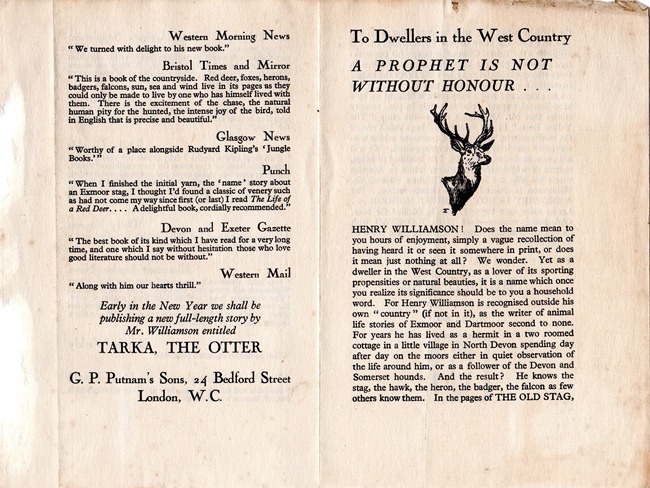
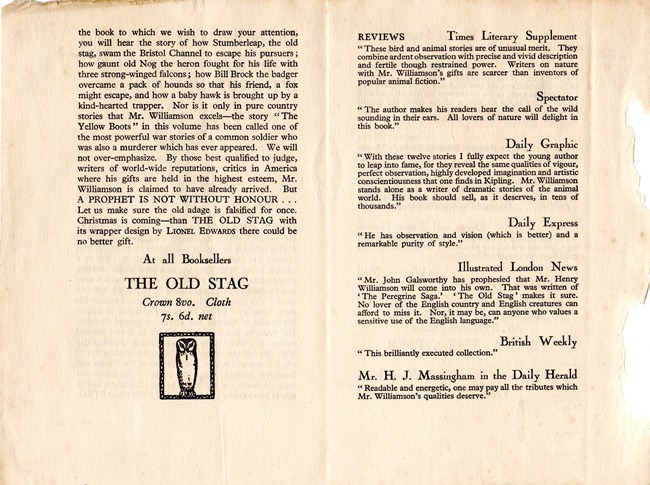
*************************
As with The Peregrine’s Saga, there is confusion and mixing of stories in subsequent editions. Dutton’s American edition followed the Putnam first edition, but when it came to Putnam’s new edition of 1933, illustrated by Charles Tunnicliffe as part of the matching set of four nature story volumes, some changes occur.
This new edition starts with ‘The Trapper’s Mates’ and ends with ‘Stumberleap’. Some stories were omitted: ‘No Eel for Nog’, ‘Mewliboy’, ‘Chakchek’s Raid on London’ (which was taken into the new Peregrine’s Saga edition as ‘The Outlaw’), ‘The Yellow Boots’, and ‘The Old Pond’ (now in the new Lone Swallows edition). Instead are added: ‘Zoë’ (from The Peregrine’s Saga first edition), ‘Redeye’ (ditto), and ‘The Epic of Brock the Badger’, four stories from various sources now consolidated as one long item.
One small point of interest is that the Christmas card sent out by Henry and Loetitia in 1932 (before the illustrated edition had been published) was a reproduction of an illustration from The Old Stag: ‘Staghounds at Cloutsham’.
This illustrated edition was reprinted several times during the 1940s, including an edition by Penguin in 1942, complete with full illustrations – quite an achievement during those very austere war years, when paper and permission to print were hard to come by. It has a most poignant printed message on the title page:
FOR THE FORCES
Leave this book at a Post Office when you have read it,
So that men and women in the services may enjoy it too.
Opposite is an advert for Mars Bars – young people could only earn one if they had ‘Dug for Victory’!
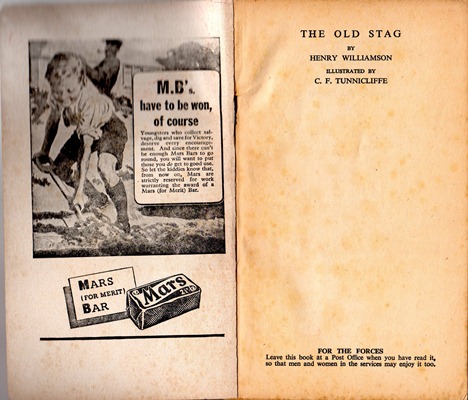
Penguin's author blurb:

*************************
Times Literary Supplement (unsigned), 25 November 1926 (2½ 9-inch columns):
These bird and animal stories are of unusual, though unequal, merit. They combine ardent observation with precise and vivid description, and fertile, though restrained, inventiveness. . . . Writers on nature with Mr. Williamson’s gifts are scarcer than . . . [but] we should like to see him confine himself within the limits of unvarying accuracy.
The book show traces of immaturity which may be arrested development due to the upheaval of the war. . . . [The reviewer is worried by the extreme ‘grimness’ of some of the stories.]
The Bookman (unsigned), 26 December 1926:
This is a book quite out of the ordinary as regards both matter and style. It is described as a “country-side” book but it is as different . . . as champagne is from ginger-ale. Mr. Williamson . . . is a naturalist whose passion for birds and animals has inspired him to the closest possible intimacy and sympathy with them . . . [but also] he is an artist in words, with a native genius for the short story. . . . Altogether there are a dozen tales, which are a triumph alike of the naturalist’s and the short-story writers’ art.
Saturday Review (L. P. Hartley), 27 November 1926:
Anyone who enjoys Richard Jefferies or who has wept over “The Story of a Red Deer” will find . . . a book to cherish. It depicts Nature red in tooth and claw; . . . Blood is spilled in plenty. The book is full of terse, nervous, beautiful writing: it is a pity Mr. Williamson does not extend his range beyond the dominion of fur, feather and fin. [But surely he does? (‘Fur, Feather, and Fin’ was a series of books on sporting subjects – today collectors’ items.)]
The Observer (unsigned), 23 January 1927:
Mr. Henry Williamson is of the elect. In “The Old Stag” he brings to the printed page something of the elusive charm of Richard Jefferies and Alfred Rees. . . . Mr. Williamson is master of vivid phrase. . . . When he enters into the lives of birds and beasts . . . his subconscious mind is busily at work; it maybe that from depths beyond fathoming old memories stir. How closely Mr. Williamson is in touch with actuality, this collection of a dozen memorable stories proves beyond question.
The Bookseller, November 1926:
This is a novel of the country by an author who has the knack of description, of the excitement and the joy of the chase and the temperament of men who love all animals. The tale is set in the time of coaches and curtseys and of challenges, for which there will always be an appreciative public.
Manchester Dispatch, 11 November 1926:
An example of how nature stories should be written. The author has the seeing eye and the understanding heart. . . . he lets his readers see what he has seen, so that they understand also. He tells of the hunters and the hunted . . . A great book.
Liverpool Courier, 12 December 1926:
Mr. Henry Williamson writes remarkable studies of wild life in the Southern Counties. If . . . his imagination occasionally becomes exuberant, he can easily be forgiven. His detailed work often touches genius, and the denoument of yarns, like the gruesome “Yellow Boots” or the quaint “Jelly Bogs” [sic] is startling and entirely unexpected.
The London Mercury (Ed Shanks), 26 December 1926 (this cutting has obviously had previous text not supplied):
Mr. Henry Williamson has greater merit than this, but none more surprising than that he writes of animals as animals and not as if they were human beings in animal skins. I will not presume to extol his knowledge of wild life: I can only say that to me, who have next to none, it carries conviction, if for no other reason than that his stag in a quandary is not shown reasoning as would a man but simply acting like a stag. Beyond this, one must praise the cool and ordered strenuousness of Mr. Williamson’s style which will make his book attractive to many readers who avoid books about wild animals more anxiously than they avoid the animals themselves.
Pop. Pictorial (with a hand-written date of June ’26 – but this must be incorrect). After a short somewhat erroneous biographical paragraph, it continues:
His [HW’s] last book, “The Old Stag” seems to have really caught on. It is queer how many contemporary men of fame either live or were born near Barnstaple. P.G. Wodehouse’s father is parson of Bratton Fleming. W.N.P. Barbellion lived there. Hubert Bath was born there, so was “Saki”, Geoffrey Dennis, who wrote “Mary Lee”, Randolph Schwabe, the artist, and now Williamson, who in the opinion of some of our critics will outlive the lot.
Colour – not dated but has to be 1928:
To return from “Point and Counter Point” * this book is like leaving an apache cafe at four o’clock in the morning and seeing the sun rise over Exmoor in May. There is blood in this book . . . but it is natural, clean, healthy blood . . . . Mr. Henry Williamson has been called a genius, and a genius he certainly is. . . .
*[by Aldous Huxley, pub. 1928 – by extraordinary coincidence this book is about D. H. Lawrence and John Middleton Murry, the latter becoming a great friend of HW.]
Daily Graphic (S. P. B. Mais), 3 October 1926:
With the twelve remarkable stories contained in this volume I fully expect this young author to leap into fame, for they reveal the same qualities of vigour, perfect observation, highly developed imagination, and artistic conscientiousness that one finds in Kipling. . . . Mr. Williamson stands quite alone as a writer of dramatic stories of the animal world.
Sunday Times (S. P. B. Mais), 5 December 1926 (this is a short sentence at the end of a list of books):
Henry Williamson’s “The Old Stag” has been hailed as the best collection of animal stories since Sir John Fortescue’s “The Story of a Red Deer”.
John O’London's Weekly, 14 December 1926:
The Call of the Open did not cry in vain to Mr. Henry Williamson, the author of “The Old Stag”, who not so very long ago was a journalist working in Fleet Street . . . [repeats the story behind “Will Side-whiskers Return?”, HW’s early article] that set Mr. Williamson walking straight out of London, for thirty miles a day, until he came to a little village in Devonshire where he has lived ever since . . . [Present readers will understand that this is not quite accurate!]
Daily Herald (H. J. Massingham), 17 November 1926:
Mr. Williamson’s collection of what I suppose would be called “Nature Stories” are readable and energetic. . . . All the pieces are narratives or dramatic scenes and, as this is never the way of Nature, the author is forced to take certain arbitrary liberties with his material. . . .
These of course are not animals at all; they are theriomorphic monstrosities, or, in simpler language, conventional types of men in fiction masquerading as birds and animals . . . The book represents, in fact, a marriage of incompatibles; there is no fundamental unity, and, in consequence, no marriage.
One may pay all the tributes which Mr. Williamson’s qualities as a writer deserves but that does not save the book from being a failure because it has come down pretty heavily between two stools.
Yorkshire Post, 3 March 1928 [?] (Compares The Old Stag to Sir John Fortescue’s The Story of a Red Deer):
We can say with perfect truth that it is worthy to be placed in its company [with no more than two or three others] which one feels will live for all time . . .
Queen (H. L. Morrow), 20 October 1926:
[following a previous review of a ‘nature’ book] . . . Mr Henry Williamson takes us for long walks and rides in the country, never pointing out things but letting us quietly into the confidence of foxes, herons, badgers, falcons, and red-deer. [a quote follows] That is Mr. Williamson’s method, and with all due deference to the naturalists, I think it is the best way.
Daily Express (J. B. Morton, ‘Beachcomber’), 12 August 1927:
Every line I read about a stag-hunt, I know it is going to end in the same silly way. [This continues in satirical vein, involving using Lewis guns and portable field telephones at fox-hunts.] The best story of a stag-hunt is “Stumberleap” by Henry Williamson.
Punch, 1 November 1926:
Animal books always please me, fact, fiction or fairy-tale; and Mr. HENRY WILLIAMSON’S collection of short stories, The Old Stag (PUTNAM) is no exception, unless indeed it be that it has exceptionally pleased. In fact, when I had finished the initial yarn, the “name” story, about an Exmoor stag, I thought I’d found a classic of venery such as had not come my way since first (or last) I read The Life of a Red Deer. . . . “The Old Stag” (he runs, fortunately, to thirty-one pages of smallish print) is a masterpiece with which the rest of the book cannot quite keep pace, charm MR WILLIAMSON never so wisely. And charm he does, dipping his pen so to do in Pity and in Poetry and in all the “plover forest”. But I am, for all that, now going to be nasty, pernickety, and say to Mr. WILLIAMSON that he really must not . . . [basically tell tall stories in a book of true stories] but . . . all is forgiven and a delightful book cordially recommended.
********************
There are a large number of reviews of the American Dutton edition, although many are short and repetitive, from across the continent.
New York Tribune (Samuel Scoville Jr), 4 September 1927:
Writers of animal stories, like all Gaul, are divided into three parts: those with information, those with imagination, those with both. Henry Williamson belongs to the latter class. . . .
Night and day the author has watched the life and death of our lesser brethren . . . He dreams over what he sees and his dreams are clouded with the gloom of a celtic nature. . . . In fact, few of them can be called pleasant reading . . . this lingering over cruelties and suffering and death makes the book rough going to all “happy enders” while the colour of the cover, a ghastly combination of pink and purple, is another handicap to the wide circulation the book deserves.
Despite all superficial defects, “The Old Stag” is an accomplishment in craftsmanship, a fabric whose warp is of first class facts over a woof of restrained imagination shot here and there by gleams of pure fantasy.
Evening World, New York, 14 May 1927 (The first half of this review is devoted to “Runaway Days” by Samuel Scoville Jr – the above reviewer! The reviewer here would seem to have read The Old Stag in a hurry: HW undoubtedly fumed!):
. . . one discovers confusing titles such as “No Eel for Nog”; “Mewliboy”; . . . Adventuring further, one discovers that “Nog” is the name of a dog. “Mewliboy” is the name of a chicken. . . . [!!!!!!!!]
Herald, Boston (in a 14½-inch column):
[The reviewer states over two longish paragraphs that he is very definitely anti-hunting and all its attendant barbaric customs (blooding etc). Books on the subject] . . . are not for us, pacifists in our attitude towards animals. . . . [but] Mr Williamson has already shown he is a sympathetic poetic naturalist, who writes delightfully, unconventionally, humorously. In “The Old Stag” he is on the side of the [fox etc. – goes through the stories] . . . It’s a good book, this “Old Stag”; a capital book for those who hunt; for those who are hunted by Black Care.
Gazette, Charleston, 23 October 1927; its review opens with a multiplicity of headings:
‘The Old Stag’
Good Group of Nature Stories
Henry Williamson’s Stories Give Clear Insight Into
Animal Natures, Haunts and Habits
Entertains Adults and Children alike
Author Dramatizes Struggles and Tragedies of Animal Life
In Manner Only Artist Can Achieve
[Followed by a 9-inch column which ends:]
Mr Williamson is not a sentimentalist but he feels deeply the sorrows and joys of his animal friends and he expresses beautifully what he feels. . . . He regrets the eternal warfare . . . but he is philosophical about it.
New York Times:
In literary skill, native equipment and innate interest, Henry Williamson is of the elect among nature writers [although being English some of it is alien to Americans]. Notwithstanding the handicap, those who enjoy nature tales . . . this new one . . . proves him to have a distinctive gift of his own, a personal way of looking at nature and writing about it, different from the spirit and method of any other, and sets him apart . . . [in total a 9-inch column of insightful praise].
Putnam, December 1926
This story, so central to The Old Stag, was also published as a separate booklet, and appears to have been a free item sent out by the publishers as some kind of Christmas advertising project. It seems rather an odd thing to have done. Its cover imitates that of the main book, but using the separate title. Apart from HW’s story there are six pages of advertisements for other books.

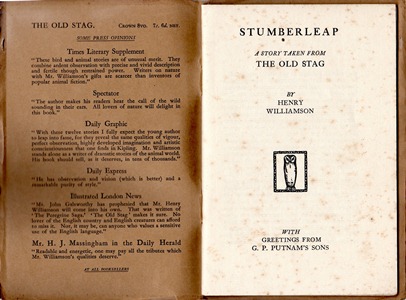
The story was later reprinted in the Daily Express over four days from 18-21 March 1930 under the heading 'THE FINEST ANIMAL STORY EVER WRITTEN'. It has been further gathered into Stumberleap, and other Devon writings: Contributions to the Daily Express and Sunday Express, 1915-1935, compiled and edited by John Gregory, and published by the Henry Williamson Society, 2005; e-book edition 2013. This latter volume should be taken into account as a very important part of HW's writing at this period, for apart from illustrating his progress as a writer and the wide range of his subjects, it also helps to reveal the full extent of his extraordinary writing output. We owe a great deal to John Gregory for his persistence in tracking down and publishing this important area of HW's writing.
The dust wrapper of the first edition, Putnam, 1926:

The dust wrapper of the scarce first illustrated edition, Putnam, 1933:
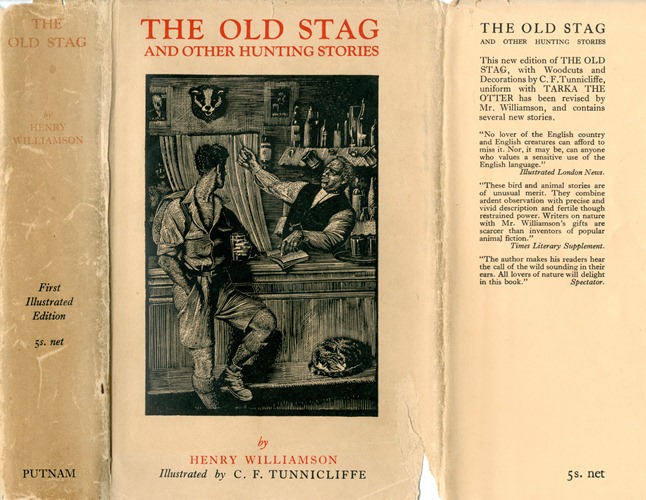
The dust wrapper of the more common cheap illustrated edition, Putnam, 1933 (often wrongly described and sold as the first illustrated edition):
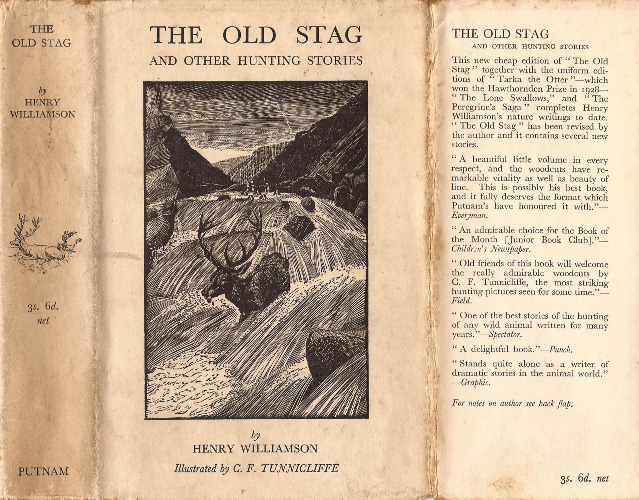
The first US edition, Dutton, 1927; front of book, and front and back flaps of the cover:
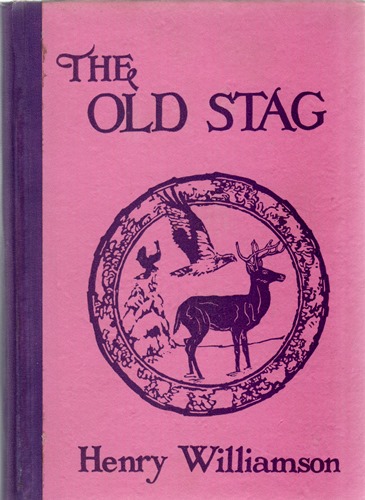
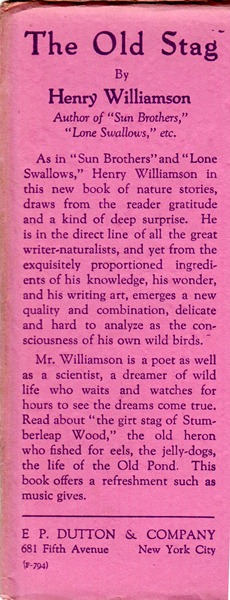
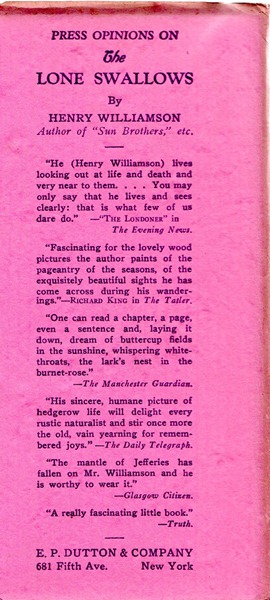
*************************
Back to 'A Life's Work' Back to 'The Peregrine's Saga'
